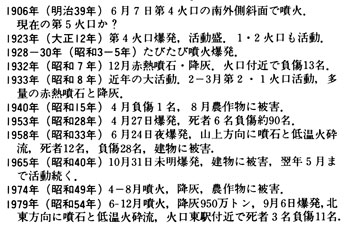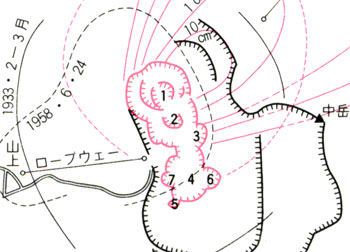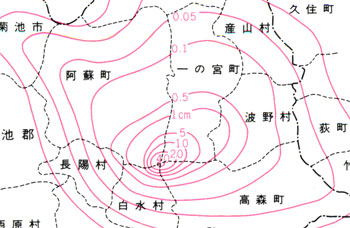Eruptive activities
A description of eruption in AD 553 is found described in a historical document, Tsukushi Fudoki. This is the oldest description of volcanic activity in Japan. Subsequently over 100 activities have been recorded between 13 and 19 centuries. Between 1901 to 1980 spanning 80 years, eruptions and ash falls are recorded in 61 years. Although records in earlier times are not very clear, similar intensity of activities are expected to have been occurring for the last several centuries. Craters No. 1, 2, 3, and 4, the details of which are to be described, were often called North, Middle, and South Ponds in historical records suggesting that the craters were filled with water and at the time of eruptions they overflowed. Probably the water levels were higher than those at present. Major activities in the last 100 years are listed in ![]() Table 3.
Table 3.
Craters of Nakadake are numbered from 1 to 7 ( ![]() Fig. 5 ), among which major ones are from No. 1 to 4. When the Observatory was opened in 1931, Nos. 1, 2, and 4 were active with rising column of smoke and No. 4 continued the activity until 1929. However, No. 4 after 1930 and No.2 after 1934 the activities have weakened and currently only No. 1 is active. During non-active periods craters held water ( This stage is called 'yudamari', meaning hot water pools ) and steam rises from surrounding areas (
Fig. 5 ), among which major ones are from No. 1 to 4. When the Observatory was opened in 1931, Nos. 1, 2, and 4 were active with rising column of smoke and No. 4 continued the activity until 1929. However, No. 4 after 1930 and No.2 after 1934 the activities have weakened and currently only No. 1 is active. During non-active periods craters held water ( This stage is called 'yudamari', meaning hot water pools ) and steam rises from surrounding areas ( ![]() Table 4 ). Yudamari since 1980 became almost dry by the end of 1984 and ash consisting of essential materials was ejected in January 1985, first time for 5 years.
Table 4 ). Yudamari since 1980 became almost dry by the end of 1984 and ash consisting of essential materials was ejected in January 1985, first time for 5 years.
Smoke column type activities Characteristic type of activity of Aso volcano is ejection of fine-grained black ash ( locally called 'yona' ). Most ash during eruption consists of glass fragments and phenocrysts formed by quenching of basaltic andesite magma. The ash is ejected either as continuous grey-brown smoke column or as accompanied with small eruptions repeating at 1 to several tens of minutes. The height of eruption column is usually less than 1,000 m and from which ash fall occurs in the downwind direction of prevailing wind. In ![]() Fig. 6 is shown ash fall distribution during June-August 1979 indicating that in this particular time interval there was not much deviation in the wind direction. From June 1979 to January 1980 a total of 9,500,000 tons of ash was ejected.
Fig. 6 is shown ash fall distribution during June-August 1979 indicating that in this particular time interval there was not much deviation in the wind direction. From June 1979 to January 1980 a total of 9,500,000 tons of ash was ejected.
Fine-grained ash is distributed in wide areas causing damage to agriculture and fishery. If the activity continues for a long-term, the effects would be felt in the fields of public health and sanitation. Great amount of unconsolidated ash deposited around the craters washed down to the valleys may result in the secondary damage such as mud flows and debris avalanches.
During active eruptions of characteristic Strombolian type activities, ballistic ejections of half-consolidated fragments of magma are common. In recent years in this type of activities, volcanic bombs ejected to outside of craters have been rare. However, during 1933 eruption, a fragment of lava with several m in diameter was ejected to outside of the crater. In the west of latest pyroclastic cone and wall of No.4 crater are exposed welded lava driblets. Also birth of new cone was recorded in documents suggesting that large-scale Strombolian activities occurred during historical times.
Explosive type activities Human casualties due to ejection of blocks in recent years in large-scale eruptions are all from cinders ( ![]() Fig. 5 ). On June 24th 1958 and September 6th 1979 small-scale pyroclastic flows accompanied with ballistic ejections of blocks caused damage to buildings. Ejected blocks classified as accessory materials were mostly from around vent, but some blocks were essential materials derived from active magma. At the time of the eruption of June 1958 no smoke column involving essential materials was observed. On the other hand, during large eruption of 1933 and active period in 1974, a large amount of essential materials was ejected as eruption columns but no blocks were ejected. Therefore, explosive activities are not necessarily related to the ejections of essential materials. From mitigation of damage point of view, this point has to be noted.
Fig. 5 ). On June 24th 1958 and September 6th 1979 small-scale pyroclastic flows accompanied with ballistic ejections of blocks caused damage to buildings. Ejected blocks classified as accessory materials were mostly from around vent, but some blocks were essential materials derived from active magma. At the time of the eruption of June 1958 no smoke column involving essential materials was observed. On the other hand, during large eruption of 1933 and active period in 1974, a large amount of essential materials was ejected as eruption columns but no blocks were ejected. Therefore, explosive activities are not necessarily related to the ejections of essential materials. From mitigation of damage point of view, this point has to be noted.



